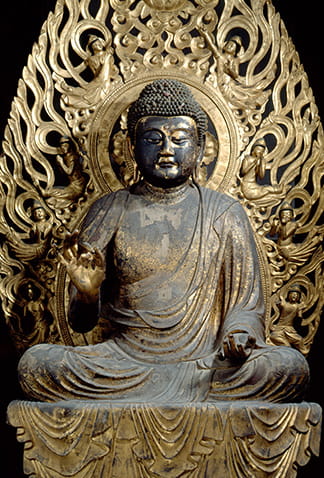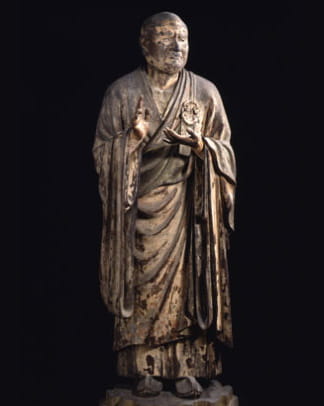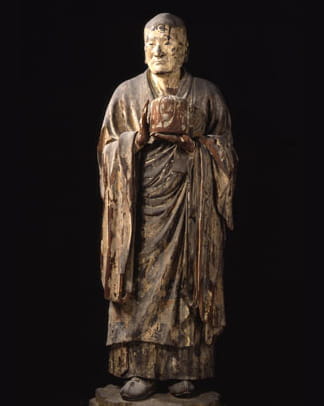Northern Round Hall
National Treasure
Miroku Nyorai(National Treasure)

This image of Miroku Nyorai (Skt. Maitreya) is the principal icon of the Northern Round Hall, and is attributed to the workshop of the renowned sculptor Unkei (1150–1223). According to Buddhist tradition, Miroku is the immediate successor of Shaka (Skt. Śākyamuni), the historical Buddha, and will be born in this world in 5.67 billion years to become its next Buddha. Here he is depicted as a fully awakened Buddha, foreshadowing his future appearance in this world.
Document inserted into the body of the statue show that it was completed in 1212.
In addition, the names of a number of sculptors of the Kei School, such as Genkei, Jōkei, Unka, Unjo, Unkaku, Tankei, Kōben, Kōun, and Kōshō, were recorded in ink on the inner face of the image’s seat. Taken together, this evidence suggests that the image was executed by a team of sculptors led by Genkei under the overall supervision of Unkei. Since it is Unkei who is considered to have conceived the image and guided its construction, it is often singled out as a representative example of his mature style.
Mujaku and Seshin(National Treasures)


Mujaku (Skt. Asaṅga) and Seshin (Vasubandhu) are a pair of famous scholar-monks who lived in North-western India during the fourth and fifth centuries, and are traditionally said to have been brothers.
According to legend, Mujaku persuaded the future Buddha Miroku (Skt. Maitreya) to manifest in the world and preach the Dharma (Buddhist teaching). After recording and editing Miroku’s teachings, Mujaku passed them on to his younger brother Seshin, who developed the philosophical ideas contained in Mujaku’s works even further. In the process, the two brothers composed a group of texts that form the basis of the Hossō School of Buddhist philosophy. For this reason, followers of the school, of which Kohfukuji is the head temple, venerate the pair as its founding patriarchs.
The images date to around 1212, and are attributed to the famous Buddhist sculptor Unkei (1150–1223). In sculpting these very lifelike figures, Unkei attempted to express the ideal of a Buddhist practitioner in a manner that transcends ethnicity or historical context. Though they form a pair, the expressions on the faces of the two images are strikingly different. The aged and slightly gaunt Mujaku gazes down gently upon living beings while clutching a cloth-wrapped parcel to his chest. His younger brother Seshin, meanwhile, is depicted as a middle-aged man who stares off into the distance with fierce determination. The massive bodies of both images convey a sense of dignity and grandeur, while their crystal eyes make their faces come alive to an uncanny degree. For these reasons, they are considered not merely representative works of Unkei’s oeuvre, but indeed two of the greatest works of Japanese sculpture ever produced.

